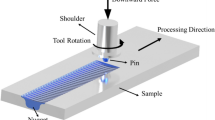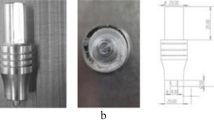Abstract
A rheological forging process to fabricate engineering components of A6061 wrought aluminum alloy with a controlled liquid fraction has been proposed and mechanical properties of the products characterized. The process uses a medium pressure of below 45 MPa and electromagnetic stirring (EMS). The processing parameters such as injection velocity, injection pressure, and stirring time were optimized to obtain improved mechanical properties. It was also possible to determine injection time and stirring time by measuring the temperature of molten metal in the sleeve. After the products were manufactured by using EMS, their microstructure and mechanical properties were investigated by image analysis, comparing to parts produced without EMS. Those products fabricated by EMS had better mechanical properties and had over 20% higher globular microstructures than those fabricated without EMS.
Similar content being viewed by others
References
Shinobo O (1994) Research activities in rheo technology Ltd. In: Proc 3rd Int Conf on Semi-Solid Processing Alloys and Composites, Institute of Industrial Science University of Tokyo, Japan, pp 7–18
Kang CG, Seo PK, Jeon YP (2005) Thixo die-casting process for fabrication of thin-type component with wrought aluminum alloys and its formability limitation. J Mater Process Technol 160:59–69
Sukumaran K, Pai BC, Chakraborty M (2004) The effect of isothermal mechanical stirring on an al-si alloy in the semisolid condition. Mater Sci Eng A 369:275–283
Zoqui EJ, Pase M, Es-Sadiqi E (2002) Macro and microstructure analysis of SSM A356 produced by electromagnetic stirring. J Mater Process Technol 120:365–373
Zoqui EJ, Shehata MT, Pase M, Kao V, Es-Sadiqi E (2002) Morphological evolution of SSM A356 during partial remelting. Mater Sci Eng A 325(1–2):38–53
Ji S, Fan Z, Bevis MJ (2001) Semi-solid processing of engineering alloys by a twin-screw rheomoulding process. Mater Sci Eng A 299:210–217
Kapranos P, Atkinson HV (2002) Thixoforming 2014, 6082, 7010 and 7075 aluminum wrought alloys. In: Proceeding of the 7th Int. Conf. on the Semi-Solid Processing of Alloys and Composites, pp 167–171
Young KP, Fitze R (1994) Semi-solid metal cast aluminum automotive components. In: Kiuchi M (ed) The 3rd Int. Conf. on semi-solid processing of alloy and composites, Tokyo, Japan, June 13-15, pp 155–176
Sato S, Adachi M, Sasaki H, Harada Y, Maeda T, Ishibashi N (2002) Defects in casting made with new rheocasting process and countermeasures for them. In: Yasukata T., Manabu K., Kiyoshi I (eds) Proceeding of 7th the Int. Conf. on Semi-Solid Processing of Alloys and Composites, Tsukuba, Japan, September 25–27, pp 647–652
Lee SW, Ye BJ (1999) The variation of pore distribution behavior according to melt treatments for AI alloys. J Kor Foundrymen’s Soc 19(2):134–141
Liu Z, Mao W, Zhao Z (2006) Research on semi-solid slurry of a hypoeutectic Al-Si alloy prepared by low superheat pouring and weak electromagnetic stirring. Rare Metals 25(2):177183
Nafisi S, Emadi D, Shehata MT, Ghomashchi R (2006) Effects of electromagnetic stirring and superheat on the microstructural characteristics of Al-Si-Fe alloy. Mater Sci Eng A 432:71–83
Robles Hernandez FC, Sokolowski JH (2006) Comparison among chemical and electromagnetic stirring and vibration melt treatments for Al-Si hypereutectic alloys. J Alloys Compounds 426:205–212
Biswas K, Hermann R, Das J, Priede J, Gerbeth G, Acker J (2006) Tailoring the microstructure and mechanical properties of Ti-Al alloy using a novel electromagnetic stirring method. Scripta Mater 55:1143–1146
Campbell J (1991) In: Castings, Butterworth-Heinemann Ltd, pp 183, 193, 205
Lee JH, Kim HS, Hong SI, Won CW, Cho SS, Chun BS (1999) Effect of die, geometry on the microstructure of indirect squeeze cast and gravity die cast 5083 wrought al alloy and numerical analysis of the cooling behavior. J Mater Process Technol 96:188–197
Author information
Authors and Affiliations
Corresponding author
Rights and permissions
About this article
Cite this article
Kim, T.W., Lee, S.M., Kang, C.G. et al. Rheological forging process of A6061 wrought aluminum alloy with controlled liquid fraction by electromagnetic stirring system. Int J Adv Manuf Technol 40, 242–252 (2009). https://doi.org/10.1007/s00170-007-1331-2
Received:
Accepted:
Published:
Issue Date:
DOI: https://doi.org/10.1007/s00170-007-1331-2




